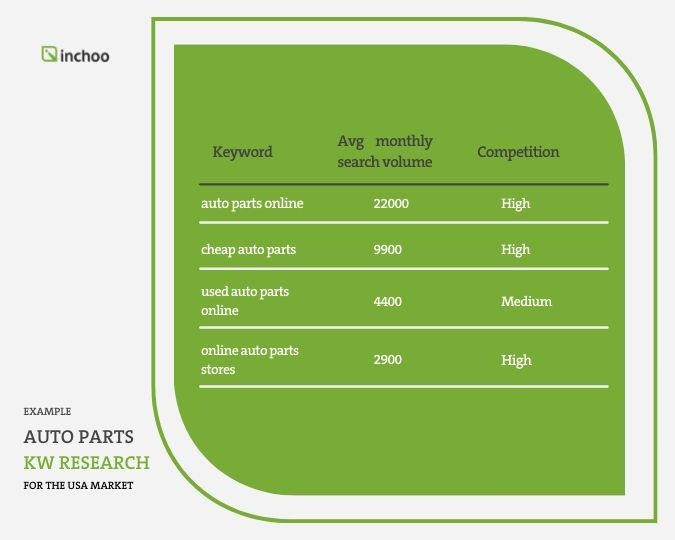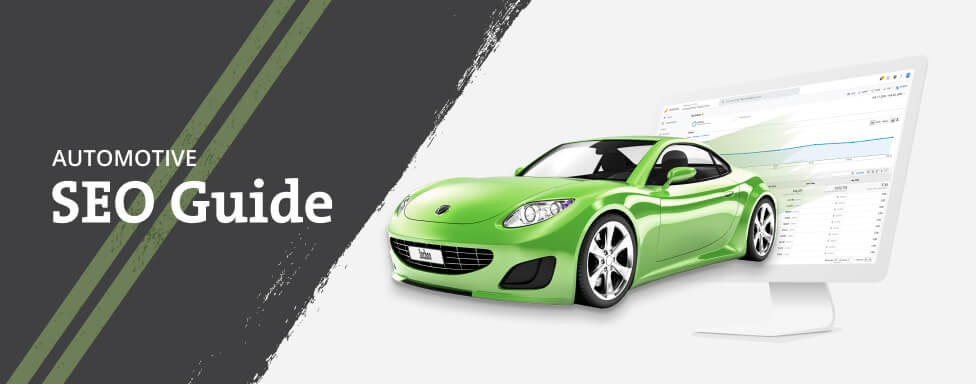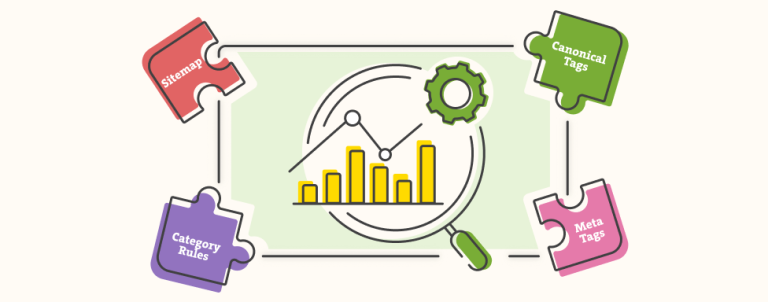As we all know, marketing is important for every possible business but especially for competitive industries like the automotive industry. Besides old fashion marketing channels, we can’t forget digital marketing and especially Search Engine Optimization. Having so much experience specifically in automotive eCommerce development, design, and digital marketing, we’ve prepared an ultimate SEO guide for everyone who finds themself at the start of this journey.
SEO for the automotive industry plays a big role in marketing your automotive or car dealerships webshop. It can be described as a process of building and optimizing the webshop to meet the high ranking demands of search engine algorithms (like Google, Bing, DuckDuckGo, etc.) and even higher demands from consumers who are looking to find the best car to buy, to find best repair services to repair their cars or to buy aftermarket car parts for their vehicles.
Automotive SEO strategy has its specifics, and they will be covered in the following chapters:
- SEO for the automotive industry
- On-site SEO elements in the automotive industry
- Technical SEO for the automotive industry
Quality SEO strategy can be a foundation for success, especially in the case of competitive markets like automotive. The result? Higher conversion rates and more revenue!
SEO for the automotive industry – how and what to do?
Search engine optimization is a complex field to cover in one article, so we will point out a few on-page advice and focus on real technical challenges with which your webshop can struggle. It should definitely be included as part of your digital marketing strategy.
On-page SEO is the practice of optimizing your website for specific keywords to reach higher positions on search engines in order to improve your website visibility and attract more visitors.
Before we go with the most important on-page elements, let’s focus on the most important aspect of SEO and every website optimization – keywords.
Keywords – THE foundation of SEO
Keywords are phrases that you want to represent your website, webshop, product, or service. We all know that when you need something, you go to search engines and type words or phrases that you want to find or to get an answer for your needs.
Appropriate keyword research is the most important step in your optimization process. Why? Because you need to know where to start, what to write, which keywords to use, and most importantly, to know what your potential customers are searching for.
Due to high competitiveness, it’s really important to dig deep into the market and find the best possible keywords with perfect search volume and competition ratio (high search volume and low competition).
Pro tip
Use long-tail keywords! Precisely tailored phrases with 3 or more words for a particular car model, equipment, or type. Don’t forget about short and highly competitive keywords, but focus on answering exact customers’ questions.
To conduct perfect and deep keyword research you need to:
- Check your current keywords
- use tools like Google Search Console and Google Analytics to find best performing keywords and URLs on your website
- Check the competitors
- see what keywords are they using (maybe you are missing some interesting categories or subcategories)
- Check the Google
- see “People also ask” or start typing your keyword and see Google’s suggestions
- Use tools
- the Internet is full of different tools for SEO and keyword research, but to avoid paying for them, use Google Ads “keyword planner”. A most important tool is to see suggestions for specific regions, countries, or even specific cities.
- Brainstorm
- consult your colleagues, friends, and business partners. Two heads are smarter than one
- Double-check everything
Here is an example of keyword research for “auto parts online” (for the US market in English).

When you finish your keyword research, you are set to start your optimization with on-page SEO elements.
Most important on-site SEO elements in the automotive industry
URLs
Include a keyword, use real words, optimize for users, keep it short and sweet, and use hyphens between words.
Title tags (meta titles) and meta descriptions
Meta titles are one of the 2 most important SEO factors (with URLs). Every page has a meta title that appears in the SERP as a headline so use your keywords, keep it short (60-65 characters), and use Call-to-action phrases.
Meta descriptions are not a direct ranking factor but they can diversify you from your competitors so don’t forget about them. Use your keywords in them, answer specific questions (how you can solve visitors’ problems), and keep it short (140-160 characters).
Headings
Using multiple headings (from H1, and H2 all the way to H6) can help your SEO in several ways. It can help your users to read through your content but also it helps Google (and other) crawlers to understand your content better.
Internal linking
Helps Google understand the relationship between your pages but also helps your visitors to discover more about your service/products. Also, don’t forget to create a good internal linking strategy because you don’t want to confuse both Google and users.
Image optimization
Images help you make your content interesting, keep visitors longer on your page, and also help your SEO with great image titles, and alt tags. Keep your images below 100kB.
Content
Optimize your content firstly for your visitors but don’t forget about Mighty Google – use the right keywords, avoid keyword stuffing, watch out for keyword cannibalization, articulate the potential problem and give visitors a solution, break the sections for easier reading.
Your main goal is to give visitors great content that satisfies their search intent. 4 major types of search intent are
- Informational – we all need information
- Navigational – we need to find the right and specific page easily
- Commercial – we all do research before finishing the purchase
- Transactional – we are here to buy something
Pro tip
Use your target keyword at the beginning of your content. The best practice is to use it in the first 100 words. This is the sign for Google that that keyword is the primary topic of your page and also shows visitors that they are on the right page.
Technical SEO for Automotive Webshops
After we discussed important on-page SEO elements, let’s focus on specific technical problems that you can have with your automotive webshop.
Having an automotive webshop and optimizing it can be a challenging project because of various factors like vehicle type, size, engine, year, transmission, and other vehicle characteristics.
Duplicate content
One of the biggest problems with a great number of similar categories, subcategories, and products is duplicate content. Not just product or category descriptions, but the whole pages with similar content (similar products).
We are aware that it is sometimes difficult to write unique descriptions for hundreds or even thousands of products but it is recommended to try to diversify your content as much as possible.
When we are talking about duplicate content, we don’t think just about written content but also about similar pages for a similar topic, for example
Audi A4 2018 Sedan 2.0L L4 CYMC
Audi A4 2018 Sedan 2.0L L4 DBPA
At first sight, it looks like the same car, but the engine type is a really important difference. How to show Google that those pages are not the same or even important? Maybe we don’t even want to show those pages to google, maybe we just want to point out the “Audi A4 2018” category.
Indexing
Before optimizing your automotive webshop, you need to create a great indexing strategy – which pages, categories/subcategories, products, or filtered product pages you want and which you don’t want to show to search engines (index).
Indexing all your pages will destroy your crawl budget and it will confuse search engines so you need to use your keyword research to see what are potential customers searching for, which category/subcategory is important, and try to avoid duplicate content.
Having a lot of indexing pages can make your pages fight each other – keyword cannibalization, and you want to avoid that at any price. You want to have a clear picture in both search engine and visitor’s eyes of which page is most important for a specific keyword and not have 2-3-10 pages fighting for the same keyword.
We are aware that this can be a very challenging task to do, but working with eCommerce experts can help you to see things from the other side.
Canonical tags
One of the ways to fight duplicate content is canonical tags. They are critical to your SEO because they will tell search engines which URL is the primary for duplicate or very similar pages.
Ecommerce sites often use canonical tags for product pages or filtered pages. We can go back to our “Audi A4 2018 Sedan” example. Based on your keyword research you can see that there is a really small search volume for a specific Audi A4 model. In this case, you would want to show the search engine that you have a separate page for every possible Audi A4 type. But for the main page, you want your Audit A4 subcategory page to be placed on SERP.
In this way, you will give your potential customers a good user experience showing them that you have a page for every A4 type, but also you will not spread your SEO power on hundreds of different Audi A4 type pages but focus on the Audi A4 subcategory page.
Few more situations when you can use canonical tags:
- Same product in different locations
- One vehicle part but in different categories or subcategories
- Similar content
- Having a similar product description but with slight variations
- Product variations
- Same car but different vehicle type, size, engine, year, transmission, and any other vehicle characteristics
Structured data (schema markup)
Being in the eCommerce business and not using or using wrong structured data (schema markup) is a huge missing opportunity or even a problem.
Google describes structured data like:
“Structured data is a standardized machine-readable format for providing information about a page. This can improve the accuracy of Google’s understanding of your content.”
All available schema types can be found on schema.org but we will highlight just the most important ones for your automotive online store:
FAQ schema
Frequently asked questions schema allows you to point out a few most important questions and answers to be displayed in SERP for targeted keywords.

Although search engines (Google) don’t guarantee to show your rich snippets in SEPR, that doesn’t mean that you need to avoid them or miss the opportunity. By showing them, you may increase your chances of receiving clicks from SERP.
Stand out from the crowd, show users that you know your business and that you are THE answer to their questions.
ItemList schema
ItemList schema is a great way to show search engine crawlers what is happening on your category/subcategory page.
In the past, it was ok to have product schema on your category/subcategory page but now, Google doesn’t allow that you still need to show crawlers which products are on that category/subcategory page – that is why you need ItemList schema.
Just be sure that you don’t include all product data on the ItemList schema, leave the detailed description for the Product schema
Product schema
Product schema is a crucial part of your structured data markup strategy. This schema allows the search engines to see more information about your product in seconds, just by reading the quality schema.
In this schema, you can show information about a specific product like:
- Name
- Image
- Description
- SKU number
- Brand
- Type
- Rating value
- Review
- And much more

Product Review schema
It allows you to show “stars” for your category or product page in SERP. This is a great “trick” to win more potential customers from SERP.
Shoppers want to see and compare a lot of things and review rating is one of the most important (price also). Adding this schema can drastically increase your CTR (click-through rate).

As you can see on the image above, there is a wide range of possibilities to add and how to optimize your Product schema so be sure to include it on your automotive web store it will boost your ranking high!
Of course, there is a lot more structured data markup that you can add to your web store, like:
- Organization schema
- Website schema
- BreadcrumbList
Creating pages from filtered pages – yes or no
Most automotive web stores have the option to filter every vehicle by different characteristics. The question here is, do we want to create a separate URL for every filtration step?
Let’s say that you sell vehicle parts on your web store and you can filter vehicles by:
- Model
- Year
- SubModel
- Body
- Engine
- Transmission
Do you want to have a separate page for every step or just after your visitor selects all the filters? This is a very big question and needs to be answered after the detailed research.
If you choose the second option and create a new URL after all filters are selected you can miss a great opportunity for possibly great keywords. In our example, let us show you what you can miss:
- Audi A4
- Audi A4 2018
- Audi A4 2018 Premium Plus
- Audi A4 2018 Premium Plus Sedan
- Audi A4 2018 Premium Plus Sedan 2.0L L4 CYMC
- Audi A4 2018 Premium Plus Sedan 2.0L L4 CYMC 7-speed Automatic Dual Clutch 0CK
This is just an example but you can see the point. It’s really important to know your potential and what potential customers are searching for but also, to be sure not to “over-optimize” your website because that can lead to new duplicate content problems.
Another big problem is that a lot of eCommerce platforms don’t allow you to make decisions like this and to optimize your webshop by your rules. That is why we offer our ongoing SEO support for questions like this.
Canonical tags, meta robots tags (index, follow) optimization for specific pages
As we said in the previous chapter, available eCommerce solutions don’t allow you a lot of customization on really important questions like meta robots tags, canonical tags, or sitemap excluding for not-major pages (filtered pages from our last example).
This can be a really big problem because if you can’t optimize what is indexed, and which meta robots tags are implemented, you will not be able to optimize your website perfectly and that is not a solution.
Meta title, H1 tag, and Meta Description optimization for specific pages
In the same situation as in the previous chapter, it’s hard to manage Meta titles, H1 tags, and Meta descriptions for major and specific (filtered) pages.
As we all know, Meta titles and H1 tags are one of the most important elements of SEO optimization and you need to have full customization control over that. Great Meta titles can be a crucial difference between you and your competitors.
We covered the importance of Meta titles in the on-site SEO part, but here we want to point out potential problems with lack of control over specific pages like filtered pages from our car parts example.
You need to have control over all possible page types because it doesn’t mean anything to have specific filtered pages if you can’t optimize them by the best SEO practices.
XML Sitemap
Your sitemap helps search engines (like Google) understand the situation with your categories, subcategories, products, images, blog posts, and relationships between them better and easier.
Most web stores have hundreds or even thousands of URLs and it is highly recommended to spend some time optimizing your sitemap as best as possible. One more important thing to remember is that the sitemap makes your page indexation easier.
Few problems can occur without proper XML Sitemap:
- The longer time that new pages can take to index
- Product images might not be included in image search results
- Longer time for any page changes/updates to “catch”
Robots.txt
The robots.txt file provides clear guidelines for various bots to crawl your website content. Not just what to crawl but also what not to crawl which is more important.
Robots.txt file is a great way to optimize your crawl budget (amount of pages that crawlers have determined will crawl on your website) because you can exclude everything unnecessary like search result pages, pages with applied filters, and many other “thin content” pages.
Here is one general example of a robots.txt file:
# Sitemaps
Sitemap: https://www.example.com/sitemap.xml
## Crawl-delay: 5
# Sitemaps
Sitemap: https://www.handylabels.co.uk/sitemap.xml
## Crawl-delay: 5
# Image Crawler Setup
User-agent: Googlebot-Image
Disallow:
## Directories
Disallow: /*/app/
Disallow: /*/bin/
Disallow: /*/dev/
Disallow: /*/lib/
Disallow: /*/phpserver/
Disallow: /*/setup/
Disallow: /*/var/
Disallow: /*/vendor/
Disallow: /*/var/
Disallow: /*/report/
Disallow: /*/pub/
Disallow: /errors/
Disallow: /downloader/
Disallow: /cgi-bin/
Disallow: /404/
# Paths (clean URLs)
Disallow: /index.php/
Disallow: /catalog/product_compare/
Disallow: /catalog/category/view/
Disallow: /catalog/product/view/
Disallow: /control/
Disallow: /contacts/
Disallow: /customer/
Disallow: /customize/
Disallow: /newsletter/
Disallow: /sendfriend/
Disallow: /wishlist/
Disallow: /review/product/listAjax/
Disallow: /onestepcheckout/
Disallow: /customer/account/login/
## Paths (no clean URLs)
Disallow: /*?SID=
Disallow: /*/*.php$
# Clear Category Sort
Disallow: /*/*?product_list_order=*
Disallow: /*/*&product_list_order=*
Disallow: /*/*?price=*
Disallow: /*/*&price=*
Disallow: /*/*?product_list_limit=*
Disallow: /*/*&product_list_limit=*To conclude
Technical SEO for web stores is maybe the most important aspect of SEO so take it seriously or if you are not sure how to do it by yourself, ask for professional help because most of the companies working with web stores every day know how to do it but also know little things that are not that known.
From on-page off-page SEO to technical SEO there is a wide range of options that you have for your automotive search engine optimization. Working on continuous SEO of your web store will benefit you definitely so invest your time to research and find the best way to do it.



